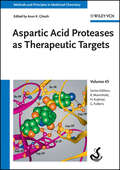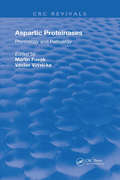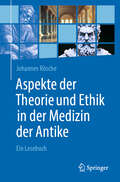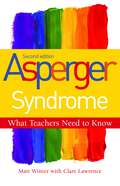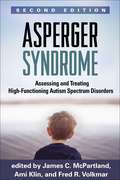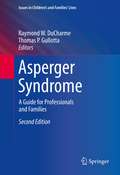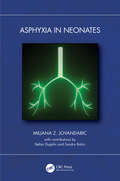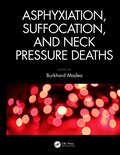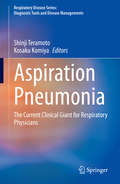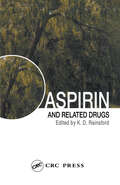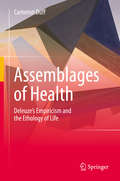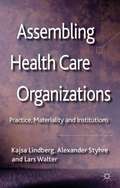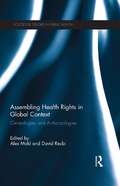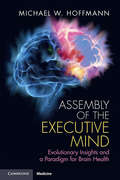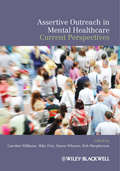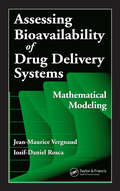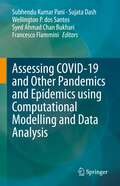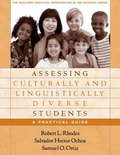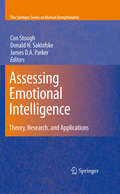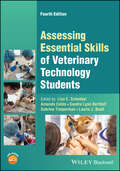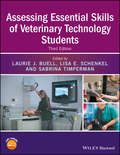- Table View
- List View
Aspartic Acid Proteases as Therapeutic Targets (Methods and Principles in Medicinal Chemistry #45)
by Raimund Mannhold Gerd Folkers Hugo KubinyiIn this ground-breaking practical reference, the family of aspartic acid proteases is described from a drug developer's perspective. The first part provides a general introduction to the family of aspartic acid proteases, their physiological functions, molecular structure and inhibition. Parts two to five present various case studies of successful protease inhibitor drug design and development, as well as current and potential uses of such inhibitors in pharmaceutical medicine, covering the major therapeutic targets HIV-1 protease, renin, beta-secretase, gamma-secretase,plasmepsins and fungal proteases. A ready reference aimed primarily at professionals in the pharmaceutical industry, as well as for anyone studying proteases and their function.
Aspartic Proteinases Physiology and Pathology (Routledge Revivals)
by Vaclav Vetvicka Martin FusekPublished in 1995: Aspartic Proteinases: Physiology and Pathology focuses on the advantages and limitations of the use of proteinases and their inhibitors in human pathology. A virus-specific aspartic proteinase enzyme is required for the maturation of a virus. If the enzyme can be eliminated, so can the maturation of the virus. This book reviews the wealth of recently published information sparked by the renewed interest in these enzymes.
Aspecten van diagnostiek en therapie bij communicatiestoornissen: Deel 10 - Handboek Stem-, Spraak- en Taalpathologie
by R. Bastiaanse P.H.O. Dejonckere K. Jansonius-Schultheiss B.J.E. Mondelaers H.F.M. Peters J. Van Borsel Sj. Van der MeulenHet Handboek Stem-Spraak-Taalpathologie verscheen tussen 1997 en 2007 gefaseerd in losse afleveringen. Daarin werd alle kennis op het gebied van de stem-, spraak- en taalpathologie vanuit verschillende disciplines samengebracht. Het Handboek is bestemd voor iedereen die klinisch-praktisch of meer theoretisch is geïnteresseerd, of vanuit een ander vakgebied hiermee in aanraking komt. Voor logopedisten, artsen, linguïsten, spraak- en taalpathologen, audiologen, pedagogen en psychologen in Nederland en België is het Handboek een onmisbare vraagbaak.Deel 10 gaat in op de effectmeting in de taal- en spraakpathologie. Tevens komen behandelelementen in de functionele therapie van stem-, spraak-, taal- en slikstoornissen aan bod.
Aspekte der Theorie und Ethik in der Medizin der Antike: Ein Lesebuch
by Johannes RöscheWie wurde in der Antike medizinisch gedacht? Was ist der Nutzen für das Leben und insbesondere für im Gesundheitssystem tätige Menschen? In diesem Buch werden die Verbindungen zwischen medizinischem Denken und Philosophie in der Antike dargestellt. Mit Empedokles und Galen werden bedeutende Persönlichkeiten vorgeführt und davon ausgehend die umfangreiche Tradition medizinischen Denkens in der Antike aufgezeigt. Ebenso werden naturphilosophische Konzepte und Ethik des Corpus hippocraticum beleuchtet. Nicht zuletzt wird im Bereich der Ethik darauf verwiesen, wie ethische Konzepte in allgemeineren philosophischen oder sozialen Systemen verankert sind.
Asperger Syndrome - What Teachers Need to Know
by Matt Winter Clare LawrenceAs awareness and diagnosis of Asperger Syndrome (AS) increases across the globe, it is essential that every teacher in every classroom has a familiarity with the condition and understands how best to support AS students at their school. This fully revised and expanded second edition is the ideal resource to point teachers in the right direction. Concise and instantly accessible, this book gives a clear summary of up-to-date information on Asperger Syndrome, describing the common characteristics to look out for, and offering simple strategies for adapting to the educational needs of students with AS. Packed with useful tips and practical advice, this guide answers key questions such as 'Am I qualified to teach this child?' and 'How can I help the pupil with AS to learn?' New material includes information for teaching older children and adolescents with AS, tips on what to do when problems arise, as well as suggestions for a whole-school approach to helping students with AS. This book is the perfect go-to guide for teachers, teaching assistants and those in school management who want to know more about Asperger Syndrome in the mainstream inclusive classroom.
Asperger Syndrome, Second Edition
by Ami Klin MD Fred R. Volkmar Maria Asperger Felder James C. McpartlandCompletely revised with the latest research and clinical strategies, this is the authoritative volume on Asperger syndrome (now part of DSM-5 autism spectrum disorder). Considered the definitive reference since its initial publication, the book focuses on how to assess each child or adolescent's needs and provide effective interventions in the areas of communication, behavior, and academic and vocational functioning. The neural and genetic bases of autism spectrum disorders are also explored. New to This Edition *Expanded coverage of evidence-based assessment and treatment, including two chapters on behavioral interventions. *Addresses challenges in the transition to new diagnostic criteria for autism spectrum disorder in DSM-5. *Chapters on neuropsychological advances, the transition to higher education, and forensic issues. *Many new authors and extensively revised chapters.
Asperger Syndrome: A Guide for Professionals and Families (Issues in Children's and Families' Lives #3)
by Thomas P. Gullotta Raymond W. DucharmeSince the first edition was published in 2003, an enormous amount of research into Asperger Syndrome (AS) and autism spectrum disorders has been conducted. New genetic and epigenetic theories, updated findings on viable therapies, and targeted skill-building programs provide a solid foundation of information for professionals to use in practice and impart to concerned families. The Second Edition of Asperger Syndrome synthesizes the current state of the field, beginning with the controversy over the proposed linking of the condition with autism in the DSM-5. This comprehensive guide gives readers a deeper understanding of the disorder, detailing the effective strategies and therapies available to improve the lives of young people with AS and ensure their successful transition from childhood to adolescence to adulthood. Focusing on core deficit and treatment areas, expert contributors analyze the evidence base on behavioral and pharmacological interventions as well as educational strategies geared toward bolstering cognitive and social skills. In addition to epidemiology, etiology, diagnosis, and assessment, this volume offers the most current information on: Counseling and other therapeutic strategies for children with AS and their families.Early intervention for children and youth with AS.Social skills instruction for children with AS.Evaluating evidence-based instruction for children with AS.Comprehensive education-based mental health services for students diagnosed on the autism spectrum.Practical advice for families, from a parent of a child with AS.The Second Edition of Asperger Syndrome is an essential reference for researchers, clinicians, and scientist-practitioners in clinical child, school, and developmental psychology; child and adolescent psychiatry; education; rehabilitation medicine/therapy; social work; and pediatrics.
Asperger's Children: The Origins Of Autism In Nazi Vienna
by Edith ShefferA groundbreaking exploration of the chilling history behind an increasingly common diagnosis. Hans Asperger, the pioneer of autism and Asperger syndrome in Nazi Vienna, has been celebrated for his compassionate defense of children with disabilities. But in this groundbreaking book, prize-winning historian Edith Sheffer exposes that Asperger was not only involved in the racial policies of Hitler’s Third Reich, he was complicit in the murder of children. As the Nazi regime slaughtered millions across Europe during World War Two, it sorted people according to race, religion, behavior, and physical condition for either treatment or elimination. Nazi psychiatrists targeted children with different kinds of minds—especially those thought to lack social skills—claiming the Reich had no place for them. Asperger and his colleagues endeavored to mold certain "autistic" children into productive citizens, while transferring others they deemed untreatable to Spiegelgrund, one of the Reich’s deadliest child-killing centers. In the first comprehensive history of the links between autism and Nazism, Sheffer uncovers how a diagnosis common today emerged from the atrocities of the Third Reich. With vivid storytelling and wide-ranging research, Asperger’s Children will move readers to rethink how societies assess, label, and treat those diagnosed with disabilities.
Asperger's Disorder (Medical Psychiatry Series)
by Manuel F. Casanova Jeffrey L. Rausch Maria E. JohnsonToday at least seven million children and adolescents are afflicted with Asperger‘s disorder. Examining the etiology, diagnosis, and treatment of this condition, this volume provides the necessary guidance to psychiatrists and neurologists so they can correctly differentiate Asperger‘s from other neurodevelopmental disorders. The book discusses bra
Asphyxia in Neonates
by Miljana Z. JovandaricIn severe asphyxia, lipid peroxidation occurs. Neonatal lipid concentration may indicate the severity of asphyxia and be a reason for needing cooling therapy. Asphyxia in Neonates describes the results of research into the impact oxygen deficits in neonates. The physiological consequences of asphyxiated newborn infants include changes in the pH of plasma and changes in lipid concentrations. These changes can result in apoptosis, loss of cell membrane integrity, and damage to the brain.Features Reviews pathophysiology of asphyxia Describes the influence of asphyxia on lipids concentrations Summarizes the weight distribution of neonates with asphyxia based on lipid concentration Illustrates the use of lipids as an indicator of prognosis following asphyxia Provides guidance for lipids parameters in cooling therapy
Asphyxiation, Suffocation, and Neck Pressure Deaths
by Burkhard MadeaCombining theory and practice, this is a comprehensive analysis of suffocation, asphyxiation, and neck pressure deaths. It includes important developments in the field such as lung histomorphology in fatal strangulation, systematic dissection of the larynx, biochemical findings, and post-mortem imaging. Given the significant challenges in accuratel
Aspiration Pneumonia: The Current Clinical Giant for Respiratory Physicians (Respiratory Disease Series: Diagnostic Tools and Disease Managements)
by Shinji Teramoto Kosaku KomiyaThis book offers an essential overview of aspiration pneumonia, and focuses on four major aspects: epidemiology, pathophysiology, new preventive strategies, and trending topics. Each part presents detailed findings and insights into critical issues for the treatment of the disease including its diagnosis, assessment, selecting antibiotics, similarities and differences between aspiration risk and aspiration pneumonia risk, different therapeutic approaches and so on. The book also discusses emerging topics concerning the definition of NHCAP and sleep apnea. Special attention is given to therapeutic and preventive approaches for the elderly, highlighting recent advances and the evidence on their positive outcomes. Since the patients with this disorder are often in a post-stroke state and elderly, the book is highly relevant for neurologists and geriatric physicians. Further, many surgeons also face this type of pneumonia in association with postoperative complications and cancer therapy related complications. Lastly, the definition of aspiration pneumonia and its therapeutic strategy have yet to be established in many countries, and the data presented here should serve as a guideline for its future diagnosis and treatment. As such, the book offers a valuable resource for primary physicians, pulmonologists, gerontologists, respiratory nurses, physical therapists, dentists and otolaryngologists alike.
Aspirin and Related Drugs
by K. D. RainsfordReviewing over a century of aspirin research and use, Aspirin and Related Drugs provides a comprehensive source of information on the history, chemistry, absorption in the body, therapeutic effects, toxicology, elimination, and future uses of aspirin.Highlighting the historical evolution of the salicylates and the commercial development of
Assemblages of Health: Deleuze's Empiricism and the Ethology of Life
by Cameron DuffThis book presents a review of Deleuze's key methods and concepts in the course of exploring how these methods may be applied in contemporary studies of health and illness. Taken from a Deleuzian perspective, health and wellbeing will be characterized as a discontinuous process of affective and relational transitions. The book argues that health, conceived in terms of the quality of life, is advanced or facilitated in the provision of new affective sensitivities and new relational capacities. Following an assessment of Deleuze's key ideas, the book will offer a series of case studies designed to illustrate how Deleuze's ideas can be applied to select health problems. This analysis draws out the specific advantages of a Deleuzian approach to public health research, establishing grounds for more widespread engagement with Deleuze's ideas across the health and social sciences.
Assembling Health Care Organizations
by Alexander Styhre Kajsa Lindberg Lars WalterAssembling Health Care Organizations combines an institutional theory perspective with a materialist view of the technologies, devices, biological specimens, and other material resources mobilized and put to work in health care work.
Assembling Health Rights in Global Context: Genealogies and Anthropologies
by Alex Mold David ReubiWhat do we mean when we talk about rights in relation to health? Where does the language of health rights come from, and what are the implications of using such a discourse? During the last 20 years there have been an increasing number of initiatives and efforts – for instance in relation to HIV/AIDS – which draw on the language, institutions and procedures of human rights in the field of global health. This book explores the historical, cultural and social context of public health activists’ increasing use of rights discourse and examines the problems it can entail in practice. Structured around three interlinked themes, this book begins by looking at what health as a right means for our understandings of citizenship and political subjectivities. It then goes on to look at how and why some health problems came to be framed as human rights issues. The final part of the book investigates what happens when health rights are put into practice – how these are implemented, realised, cited, ignored and resisted. Assembling Health Rights in Global Context provides an in-depth discussion of the historical, anthropological, social and political context of rights in health and develops much needed critical perspectives on the human rights approach to global health. It will be of interest to scholars of public health and human rights within health care as well as sociology and anthropology.
Assembly of the Executive Mind: Evolutionary Insights and a Paradigm for Brain Health
by Michael W. HoffmannOver 90% of the brain is concerned with higher cortical functions, yet understanding of syndromes, functions, and measurements remains unchartered. This valuable handbook illuminates brain function, natural environment and human function, by delving into the interdisciplinary study. Multifaceted in its perspective, this book demonstrates bi-directionality of information exchange between disciplines. This book weaves around key case reports, series, control studies and cohort studies from cognitive neurology registries, to present the most current, practical research. Gaining appreciation for the fundamental formation and assembly of the supervisory area of the brain will inform an understanding of conditions and behavior for neuroscience professionals, clinical brain scientists and medical students in neuroscience, worldwide. Authored by a leading expert in cognitive neurology, this book guides the reader through the evolutionary, or neuro-archeological, aspects of how the frontal lobes and their circuitry were assembled, drawing key insights into form, function and treatment.
Assertive Outreach in Mental Healthcare: Current Perspectives
by Mike Firn Caroline Williams Rob Macpherson Simon WharneAssertive Outreach in Mental Healthcare: Current Perspectives explores experiences, successes, interventions, and service user stories as well as lessons learned from the implementation experience surrounding assertive intervention. It provides a synthesis of expert experience in the field as well as experiences of grass roots team practitioners.This book makes a valuable contribution to the field by addressing in depth a wide range of topics critical to the delivery of assertive outreach services and providing practitioners with a manual into which they can feed lessons learned from other teams for continuous service improvement. This book is an essential reference for anyone with an interest in assertive outreach and community treatment approaches in mental health. Special features: Provides a contemporary analysis of current service developments in the area Written by experts in the field Covers cross-cutting issues relevant to all areas of community mental health care Includes multiple perspectives: service user, researcher, service manager, commissioner, clinician and carer Covers both service delivery and therapeutic interventions Explores how the assertive outreach model is applied in the UK and Europe
Assessing Bioavailablility of Drug Delivery Systems: Mathematical Modeling
by Jean-Maurice Vergnaud Iosif-Daniel RoscaExploring how to apply in vitro/in vivo correlations for controlled release dosage forms, Bioavailability of Drug Delivery Systems: Mathematical Modeling clearly elucidates this complex phenomena and provides a guide for the respective mathematical modeling. The book introduces mathematical modeling methods for calculating the profiles of plasma le
Assessing COVID-19 and Other Pandemics and Epidemics using Computational Modelling and Data Analysis
by Francesco Flammini Sujata Dash Subhendu Kumar Pani Wellington P. dos Santos Syed Ahmad Chan BukhariThis book comprehensively covers the topic of COVID-19 and other pandemics and epidemics data analytics using computational modelling. Biomedical and Health Informatics is an emerging field of research at the intersection of information science, computer science, and health care. The new era of pandemics and epidemics bring tremendous opportunities and challenges due to the plentiful and easily available medical data allowing for further analysis. The aim of pandemics and epidemics research is to ensure high-quality, efficient healthcare, better treatment and quality of life by efficiently analyzing the abundant medical, and healthcare data including patient’s data, electronic health records (EHRs) and lifestyle. In the past, it was a common requirement to have domain experts for developing models for biomedical or healthcare. However, recent advances in representation learning algorithms allow us to automatically learn the pattern and representation of the given data for the development of such models. Medical Image Mining, a novel research area (due to its large amount of medical images) are increasingly generated and stored digitally. These images are mainly in the form of: computed tomography (CT), X-ray, nuclear medicine imaging (PET, SPECT), magnetic resonance imaging (MRI) and ultrasound. Patients’ biomedical images can be digitized using data mining techniques and may help in answering several important and critical questions related to health care. Image mining in medicine can help to uncover new relationships between data and reveal new and useful information that can be helpful for scientists and biomedical practitioners. Assessing COVID-19 and Other Pandemics and Epidemics using Computational Modelling and Data Analysis will play a vital role in improving human life in response to pandemics and epidemics. The state-of-the-art approaches for data mining-based medical and health related applications will be of great value to researchers and practitioners working in biomedical, health informatics, and artificial intelligence..
Assessing Competence in Medicine and Other Health Professions
by Claudio ViolatoThis comprehensive, yet accessible, text demystifies the challenging area of competence assessement in medicine and the health sciences, providing a clear framework and the tools for anyone working or studying in this area. Written by a single, highly experienced, author, the content benefits from uniformity of style and is supported and enhanced by a range of pedagogic features including cases, questions and summaries. Essential reading for all students and practitioners of medical education, it will also be an invaluable guide for allied health professionals and psychologists with a general interest in assessment, evaluation and measurement and a useful library reference.
Assessing Culturally and Linguistically Diverse Students
by Robert Rhodes Salvador OchoaThis is the first book to present a practical, problem-solving approach and hands-on tools and techniques for assessing English-language learners and culturally diverse students in K-12 settings. It meets a crucial need among practitioners and special educators working in today's schools. Provided are research-based, step-by-step procedures for conducting effective interviews with students, parents, and teachers; making the best use of interpreters; addressing special issues in the prereferral process; and conducting accurate, unbiased assessments of academic achievement, intellectual functioning, language proficiency, and acculturation. Among the book's special features are reproducible worksheets, questionnaires, and checklists--including several in both English and Spanish--in a ready-to-use, large-size format.
Assessing Emotional Intelligence: Theory, Research, and Applications (The Springer Series on Human Exceptionality)
by James D. Parker Donald H. Saklofske Con StoughManaging human emotions plays a critical role in everyday functioning. After years of lively debate on the significance and validity of its construct, emotional intelligence (EI) has generated a robust body of theories, research studies, and measures. Assessing Emotional Intelligence: Theory, Research, and Applications strengthens this theoretical and evidence base by addressing the most recent advances and emerging possibilities in EI assessment, research, and applications. This volume demonstrates the study and application of EI across disciplines, ranging from psychometrics and neurobiology to education and industry. Assessing Emotional Intelligence carefully critiques the key measurement issues in EI, and leading experts present EI as eminently practical and thoroughly contemporary as they offer the latest findings on: EI instruments, including the EQ-I, MSCEIT, TEIQue, Genos Emotional Intelligence Inventory, and the Assessing Emotions Scale. The role of EI across clinical disorders. Training professionals and staff to apply EI in the workplace. Relationships between EI and educational outcomes. Uses of EI in sports psychology. The cross-cultural relevance of EI. As the contributors to this volume in the Springer Series on Human Exceptionality make clear, these insights and methods hold rich potential for professionals in such fields as social and personality psychology, industrial and organizational psychology, psychiatry, business, and education.
Assessing Essential Skills of Veterinary Technology Students
by Laurie J. Buell Lisa E. Schenkel Sabrina Timperman Amanda Colón Sandra Lynn BertholfStandardized assessment criteria covering all essential skills from the nine areas required by the American Veterinary Medical Association Committee on Veterinary Technician Education and Activities The newly revised and updated Fourth Edition of Assessing Essential Skills of Veterinary Technology Students provides a comprehensive review of the required American Veterinary Medical Association Committee on Veterinary Technician Education and Activities (AVMA CVTEA®) essential skills for completion of a veterinary technology degree. Each essential skill includes assessment criteria as well as decision-making instructions necessary to demonstrate proficiency both academically and professionally. The text is organized based on the categories provided by the AVMA CVTEA, making it easy for an instructor and students to locate the assessment criteria for a particular essential skill relative to their course. Several guidelines from veterinary organizations regarding standard of care in veterinary medicine have been updated since the publication of the previous edition, including 2018 A AHA Infection Control, Prevention and Biosecurity Guidelines, 2022 AAHA Pain Management Guidelines for Dogs and Cats, 2021 AAHA/AAFP Feline Life Stages Guidelines, 2019 AAHA Canine Life Stages Guidelines, 2021 AAHA Nutrition and Weight Management Guidelines, 2023 AAHA Technician Utilization Guidelines, and others. Written by highly qualified authors, Assessing Essential Skills of Veterinary Technology Students includes assessment criteria that addresses the knowledge, decision-making capabilities, and hands-on skills for the following: Pharmacologic fundamentals of drug administration, pharmacy essentials of drug dispensing, compliance with state and federal regulation, and monitoring of therapeutic responses.Ethics, jurisprudence, and communication in veterinary management.Husbandry, nutrition, and therapeutics of common domestic species, handling and restraint, patient assessment, and dental procedures in small animals.Fundamentals of and experiences with common surgical procedures, patient management and use of anesthetic equipment, proper surgical assistance, pain management, management of surgical equipment and facilities, and perioperative management.Diagnostic laboratory procedures and management of laboratory specimens and equipment, parasitology of common domestic species and diagnostic procedures for parasite, microbiologic procedure and evaluations and necropsy procedures.Avian, exotic, small, and large animal husbandry and nursing skills. The Fourth Edition of Assessing Essential Skills of Veterinary Technology Students is an essential study resource for all undergraduate students enrolled in an AVMA CVTEA accredited veterinary technology program and an excellent teaching resource for instructors of veterinary technology courses.
Assessing Essential Skills of Veterinary Technology Students
by Laurie J. Buell Lisa E. Schenkel Sabrina TimpermanAssessing Essential Skills of Veterinary Technology Students, Third Edition provides students and instructors with clear guidance on how to evaluate student performance of skills required to enter the veterinary technology profession. Provides students with clear guidance on the capabilities they are expected to demonstrate and how they will be evaluated Gives instructors a standardized framework for assessing students’ performance Offers tools for comparing standards of competency Covers management, pharmacology, medical nursing, anesthesia and analgesia, surgical nursing, laboratory procedures, radiography, laboratory animal care, and exotic animal nursing Includes access to a companion website with a downloadable log for recording progress
